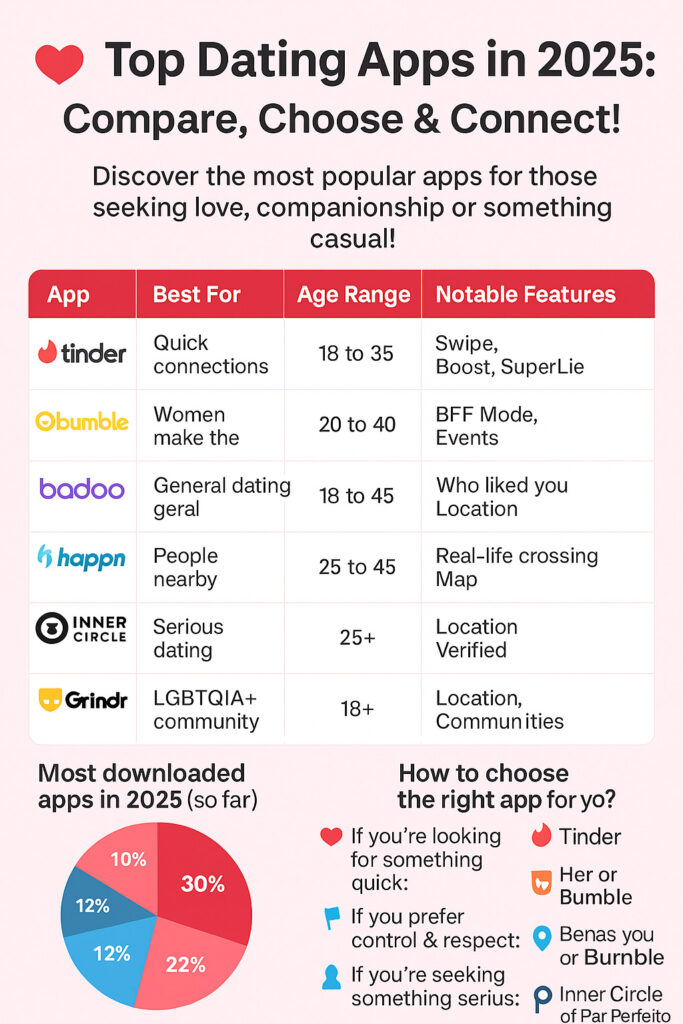ads
Choosing the right app is crucial, as it significantly affects the type of experience and the connections you’re likely to make.
Are you looking for a casual adventure, a serious relationship, or something in between? Do you prefer a quick visual assessment or a deep dive into personality traits?
This article explores some of the most important dating apps available today, analyzing their specific features and functionalities and the type of user they typically attract, helping you navigate the digital dating landscape with more confidence.
The Main Apps: Functionality and Features
Let’s break down some of the leading dating apps, examining what makes each one tick:
ads
Tinder
Main Mechanics: The iconic swipe interface. Profiles are presented to users, consisting primarily of photos and a small biography. Swipe right if interested, swipe left if not. If two users mutually swipe right, a “match” occurs, and they can begin exchanging messages within the app.
Key Features (Free):
• Swipe: The fundamental right/left swipe system.
• Location-Based Matching: Shows users within a defined geographic radius.
• Basic Profile: Upload photos, write a small bio, link Instagram/Spotify.
• Messaging: Chat with mutual matches.
ads
Bumble: Putting Women in Charge
Main Mechanics: Swipe interface similar to Tinder (right for yes, left for no). However, once a heterosexual match is made, the woman has 24 hours to send the first message. The man then has 24 hours to respond. For same-sex matches, either person can initiate [the conversation] within 24 hours.
Key Features (Free):
• Swipe & Match: Standard swipe mechanism.
• Women Initiate (Heterosexual Matches): Main differentiating feature.
• 24-Hour Time Limit: Creates a sense of urgency to initiate contact.
• Bumble BFF & Bizz Modes: Option to switch modes to find friends or professional contacts.
• Profile Verification: Photo verification helps reduce catfishing.
• Basic Filters: Set age and distance preferences.
• Video/Voice Calls: In-app call features for safer communication.
Hinge
Main Mechanics: Instead of swiping on an entire profile, users interact by “liking” or commenting on specific photos or prompt responses within a profile. This serves as the conversation starter. Users have a limited number of free likes per day, encouraging more selective choosing.
Key Features (Free):
• Prompt-Based Profiles: Users answer specific questions (e.g., “My most controversial opinion is…”, “Two truths and a lie”) along with photos.
• Like/Comment on Specific Content: Initiate interaction based on a specific photo or prompt response.
• Limited Daily Likes: Encourages users to be more selective.
• “Most Compatible” Feature: Daily suggestion based on Hinge’s algorithm.
• Basic Filters: Age, distance, height, ethnicity, religion.
• “Date from Home” Feature: Indicates interest in video dating.
OkCupid
Main Mechanics: Users answer a wide range of questions about their lifestyle, beliefs, ethics, and relationship preferences. The app uses this data to calculate a compatibility score between users.
You can browse profiles through a “Discovery” section (similar to swiping) or a “Questions” section where you see how others have answered specific prompts. Messaging is generally open (though sometimes restricted to mutual likes, depending on settings/updates).
Key Features (Free):
• Extensive Questionnaires: Answer hundreds of multiple-choice questions.
• Compatibility Scores: See a compatibility percentage with potential partners based on question answers.
• Detailed Profiles: Showcase personality through question answers and biography.
• Extensive Gender/Orientation Options: Highly inclusive platform.
• Browse & Discover: Find matches through swiping or filtering based on answers.
• See Mutual Likes: Basic functionality to see who you’ve mutually liked.
Choosing the Right App for You

With so many options, choice paralysis is real. Consider these factors:
Your Goal: Be honest. Are you looking for fun, a serious partner, or just exploring? Match your goal with the app’s general reputation (e.g., Hinge/Match for serious, Tinder/Bumble potentially more varied).
Time Commitment: Apps like OkCupid and Match require more initial setup due to detailed profiles/questions. Tinder and Bumble might be quicker to get started.
Budget: Most apps offer free tiers, but functionality is often limited. Premium features enhance the experience but come at a cost. Decide if you’re willing to pay.
Features: Do you prefer swiping or detailed profiles? Does a feature like “women send the first message” (Bumble) or prompt-based interaction (Hinge) appeal to you?
Frequently Asked Questions (FAQs)
Q1: Are dating apps safe?
A: While apps implement safety features (profile verification, blocking/reporting), risks exist. Always be cautious when sharing personal information, meet in public places for first dates, and trust your intuition.
Q2: Can you really find a serious relationship on these apps?
A: Absolutely. Millions of people have found long-term partners and spouses through dating apps, including those often perceived as “casual.” Success depends on your approach, clarity about your intentions, patience, and a bit of luck.
Q3: Do I need to pay for dating apps to be successful?
A: Not necessarily, but it can help. Free versions allow basic functionality, but premium features (like seeing who likes you or advanced filters) can save time and potentially lead to more compatible matches more quickly.


